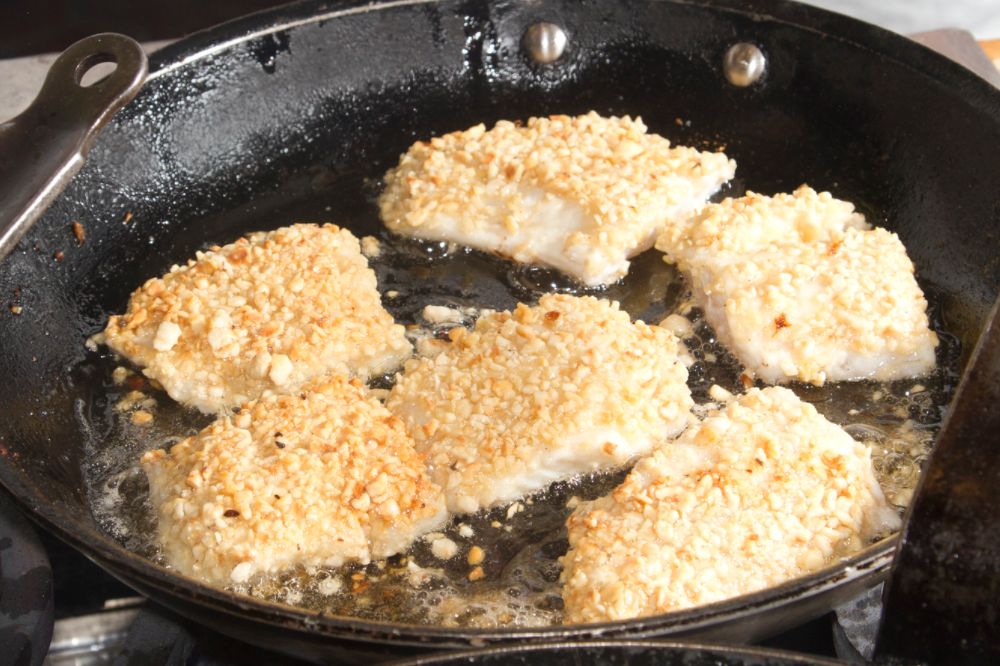It’s always worth it when you bite into that perfectly crispy fish, but frying fish at home can be troublesome, especially if you’re not a pro at frying fish. Many people complain that their fish turns out greasy or leathery when frying in oil.
While baking or air frying fish is a great way to avoid the mess and fuss of cooking in oil, it’s no substitute for the flavor and crunch of fried fish. So we want to help you learn how to cook great fried fish at home.
In many cases, the problem is that you’re not using the right oil for frying fish. Choosing the right oil is essential for getting crispy and light fish that’s not laden with grease.
» You might try this Blackened Cod recipe.

How to Choose the Best Oil for Frying Your Fish
The oil you use for frying fish can really affect the texture and taste of fish, as well as how well it fries. Hence using the right fish frying oil is essential. The vital factors to consider while choosing oil to fry your fish are listed below.
High Smoke Point Oils for Frying
The smoke point of oil is very important because it will determine how hot you can get the oil before it starts to smoke. The best oil for frying food is one that can sustain a high heat for long enough to safely and effectively fry the food.
As Serious Eats explains, “Heated past its smoke point, that fat starts to break down, releasing free radicals and a substance called acrolein, the chemical that gives burnt foods their acrid flavor and aroma.”

Oils with a high smoke point can sustain the high heat needed to fry fish properly. The temperature needed for frying properly is between 350 and 375 degrees F. Any lower and the fish will soak up too much oil, and any higher and it will burn.
It’s also important to choose an oil that can be heated to at least 50 degrees above the proper frying temp to make up for the drop in temperature that will occur when you place cold food into the pan.
- Safflower oil has a smoke point of 510°F
- Canola oil has a smoke point of 400°F
- Vegetable oil has a smoke point of 400-450°F
- Peanut oil has a smoke point of 450°F
- Clarified butter (ghee) has a smoke point of 450°F
- Coconut oil has a smoke point of 350°F
- Extra Virgin Olive Oil has a smoke point of 325-375°F

Flavor
Fish has a delicate flavor, so you need to choose oils with a neutral flavor to avoid overpowering fish. You wouldn’t want to choose extra virgin olive oil primarily because of its low smoke point, but it would also impart a strong flavor on the fish which might not taste good.
Some oils with no or very neutral flavor are canola, vegetable, and safflower. Peanut oil is great for frying, but does have a slightly nutty flavor. Clarified butter (ghee) has a slight flavor of butter that will be imparted on the fish.
So what is the best oil for flavor? My answer is peanut or canola. The nutty undertones of peanut oil can complement the fish well, without overwhelming its natural flavor. Another option is canola oil; it’s versatile and has a neutral taste that lets the fish shine.
Health Factors
You’ll always want to consider the health factors of cooking with oil. Once oil passes it’s smoke point, it begins to release free radicals that can cause damage to cells in the body.
According to Medical News Today, “Saturated and monounsaturated fats are the most stable oils to cook with […] Polyunsaturated oils contain short-chain fatty acids and break apart more easily when heated, releasing more free radicals.”
Canola, sunflower, and avocado oil are all healthy to fry with at this temperature. Peanut oil can be find too, but it contains polyunsaturated fats as well as monounsaturated.
Standard vegetable oil isn’t necessarily bad for frying fish; it’s actually a common choice due to its neutral flavor and relatively high smoke point. If you’re after something that complements the fish rather than just cooks it, you might want to explore other options.

Deep Fry Options
Both pan-frying and deep-frying fish can be done effectively with a variety of oils, but there are nuances worth considering. For pan-frying, where you typically use less oil, you might opt for something like olive oil or butter for richer flavor. However, keep an eye on the smoke point—extra virgin olive oil has a lower one and might not be the best for high-heat frying.
For deep-frying, you’ll want an oil that has a high smoke point and a neutral flavor, given the larger quantity you’ll be using. Peanut oil and canola oil are often go-to choices here. Their high smoke points make them stable at the temperatures you’ll need for deep-frying, and their flavors won’t dominate the fish.
So, if you’re looking for versatile options that work well in both scenarios, canola oil is a reliable, all-purpose choice, and peanut oil is excellent if you’re looking for a bit more flavor depth.
Best Oils for Frying Fish
As you can see from the list above, there are plenty of oils that meet the requirements of high smoke point and neutral flavor. You can choose any one of those oils and it’ll be fine, but if you’re still pondering which oil would be the best for frying fish, we’ve listed the most suitable options below.
Canola Oil
When it comes to frying fish, canola oil can be your best go-to option. It is a very light oil that isn’t too expensive. The best thing about using canola oil is that it’s readily available in all stores.
Other features that make canola oil ideal for frying fish are its high smoke point and neutral flavor. That means the oil will not overshadow the flavor of your fish.
Moreover, canola oil can also withstand high heat while cooking without the risk of breaking down.
Safflower Oil
Refined safflower oil has a high smoke point and is ideal for frying fish. However, make sure to avoid using unrefined or semi-refined safflower oil. The high smoke point and neutral flavor make it suitable for frying fish.
Moreover, safflower oil has a high content of monounsaturated fats. This makes the oil a healthy option for you.
Sunflower Oil
The most common choice of oil for frying fish is sunflower oil. Its neutral – albeit slightly nutty – flavor prevents it from interfering with the taste of your fish. High oleic sunflower oil has a smoke point of 440°F.
However, the sunflower oils with a smoke point of just 225°F are not suitable for frying fish.
Peanut Oil
Next on the list is peanut oil. If you do not mind having a little nutty-sweet flavor, then peanut oil is an option you must consider for frying fish. It has a high smoke point, but it does also have some fats that can break down into free radicals that might harm the body.
It is essential to note that peanut oil isn’t the healthiest option. However, consuming it once in a while will not harm your health.

Soybean Oil
Soybean oil is quite effective for frying fish fillets. It has a high smoke point around 450°F (232°C), making it stable at the high temperatures required for frying. Additionally, its neutral flavor won’t interfere with the taste of the fish. While it might not impart a distinct flavor like peanut or olive oil, it’s a reliable and often economical choice for frying at high temperatures.
Oil Blend
Using an oil blend can be a smart move for frying fish. Blending oils allows you to take advantage of the best qualities of each—maybe you want the high smoke point of canola oil but also a touch of the rich flavor that olive oil provides.
Just make sure to consider the lowest smoke point among the oils you’re blending, as that will be your limiting factor when heating, especially when pan frying. Mixing oils can offer a balanced profile, both in terms of flavor and frying performance. I wouldn’t use a blend for deep frying however. Stick to one high-smoke point oil.
The best oil blend would likely be something like peanut oil and canola oil (for flavor) or sunflower oil and a touch of olive oil.
FAQs
What Is the Most Suitable Oil for Frying Fish?
The most suitable oil for frying fish is the oil with a high smoke point and neutral flavor so it doesn’t overpower or interfere with the taste of the fish.
Some of the best choices are sunflower oil, canola oil, peanut oil, and safflower oil.
Can Fish Be Fried in Olive Oil?
If you plan to fry fish in olive oil, it’s perfectly healthy to do so. However, it has a lower smoke point so it’s harder to keep it at the proper temperature. It will also impart a slight olive flavor to the fish, which isn’t necessarily a bad thing.
Is Fish Fried in Olive Oil Healthy?
Without any doubt, olive oil is a healthy option for frying fish. When using olive oil for frying fish, you do not have to worry about any negative impact on your health. This is because, while it does have a lower smoke point, it has anti-inflammatory properties and is high in antioxidants and fatty acids that keep it from breaking down into free radicals.
YOU MIGHT ALSO LIKE
Like it, Love it, Want Some More of It? Subscribe to our YouTube channel to watch us cook and follow us on Pinterest, Instagram and Facebook. We really love it when you save our recipes to Pinterest 😊

Laura is a home cook, with 25 years experience behind the stove, who spends an extraordinary amount of time in the kitchen cooking. She loves making new recipes and finding wonderful new things to eat, both at home or abroad. She spends a lot of time researching, crafting, and perfecting her recipes.




